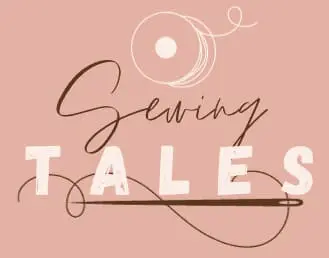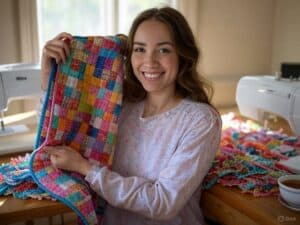Whenever someone asks me what my first project was, my brain instinctively replies, “What was I thinking?” I had convinced myself that sewing is simple, after all, it’s only fabric, a thread, and a sewing machine. But when I picked up my Simplicity pattern for the first time, I remember thinking, ‘Oh my gosh, what the heck is going on?’ There were symbols, numbers, and words I didn’t even know the meaning of.
I freaked out because I knew I wouldn’t be able to make the nice dress I wanted, and instead, it would end up as a mess. But after completing my first project, it all made sense, and the rewards were more than worth the effort. Last but most importantly, while there might be several sewing steps to complete a Simplicity pattern, I refuse to believe that they cannot be accomplished by anyone regardless of their experience level.

Now then, let’s go ahead and dissect it together and practice a few things to make sure that you become a pro in using Simplicity patterns!
1. How I Got Started: Understanding My Pattern Package
Sneak Peak Inside The Pattern Envelope
When you’re given a Simplicity pattern, it feels as if one has come across a blueprint for a chest of treasures. A few pieces of information are bound to greet you. Here, we will put it all in order:
Size Charts: This is the point where the reality begins! It is time to take your measurements and figure out what size will suit your body the best. Trust me, estimating my dimension can lead to a lot of distress. Just spare a few moments to do some measuring. Do not avoid this aspect! Believe me, patterns that are too small or too large can turn out to be extremely upsetting.
Fabric Requirements: This should be viewed as a basic fabric requirement to avoid excessive detailing. It will indicate the amount of material you will use for the garment while considering your size. If you’re anything like me, you’d think you’ll only need half the fabric, right? Don’t be entrapped out of it! Always adhere to the fabric needs of the pattern. It will help in the long run.
Notions Needed: This section tells you the extra bits and bobs you’ll need to complete your garment. For example, this could include buttons, zippers, elastic, and others. The last feeling that any worker wants to undergo is to discover most of his notions are lacking when the project is completed which is very inconvenient. I mean, imagine making a cake without eggs! That sounds ridiculous, doesn’t it?

2. Decoding the Symbols and Markings on My Sewing Pattern
Don’t get Lost in the Symbols
Alright now let us come to symbols. These are what I would describe as the sewing language, and although they may not make much sense at first, they are much less complicated than they look. So here is your roadmap of what you are supposed to look for:
Grainlines: These are shown with arrowheads having very little to span between them. These are instructions to indicate how the pattern should be placed with reference to the grain of the fabric. Just like the direction in which coffee has to flow into a mug, your fabric also has to flow in the right direction.
Cutting Lines: Cleavage of these lines is quite rare but possible. These ‘cutting lines’ assist the worker in noting the exact points to cut the fabric. Therefore, do not feel free to cut anywhere that you wish – these lines are there for a good reason.
Notches: Notches help in lining up parts when sewing the final piece. They are like little arrows that show you where to sew the different parts together. Without them, you’ll be in a fabric mess and won’t know how to find your way around.
Darts: Darts are also the best when it comes to making a garment fit properly. Darts take a piece of fabric and shape it to the contours of your body and enhance the fitting. Leave them out, and there is a chance that you will look like you have been fitted into a box instead of dressed in a fitted garment.
3. How I Arranged My Pattern Pieces and Instructions for a Smooth Sew
The Art of Arranging Things
Before you commence cutting and pinning, please organize yourself. Here is something I wish I had heard before my first (pretty messy) project: Everything has an order, and the more organized one is, the more efficient the workflow is. Going through the steps will allow you not to jump around.
Look for All Pieces: Arrange the pieces and ensure that you have the pattern in its entirety. One can probably not know much that is worse than getting a partial pattern eighteen hours down the sewing line.
Mark Each Piece: So it was this step that stopped me from losing my temper. There was no way I was going to lose my temper in a situation like this. It began to be very crucial that I start to have some order as each piece began looking pretty similar to the last. So I knew which piece was which and didn’t get my front and back pattern pieces mixed up.
Sort by Construction Order: Put the parts together according to the way the pattern instructions recommend. This helps to keep one organized and avoids the confusion that may arise when constructing one’s garment in the later stages.

4. How I Got My Fabric, Ready for Sewing: Pre-Washing, Ironing, and Avoiding Common Mistakes
Pre-Wash and Iron: Only for Certain Materials
Let me say this, not pre-washing is a beginning sewer blunder. Don’t take my word for it, I did it the hard way when I made a lovely dress and washed it only to see it shrink the first time I decided to wash it. Here’s how to make sure you’re setting yourself up for success:
Pre-Wash Your Fabric: Not all fabrics are created equal; some types will shrink and almost always do so after the first wash. Wash the fabric with regards to its type and how the manufacturer has indicated to wash it so that you do not end up with surprises later on.
Ironing Your Fabric: It is a good idea to do some ironing to your fabric before commencing any cutting. Got wrinkles and folds on the fabric and don’t want them to disturb your measurement because let’s face it, who wants to sew crooked stitches anyway? Smoothen out any wrinkles on your fabric and also ensure that your fabric is stuck to avoid creating any more unnecessary wrinkles down the line. In the future, you will appreciate it.
Fabric Grain & Layout Diagrams: There is much more than What Meets the Eye
For any fitting, it’s all about achieving the right grain. It’s like a map of the fabric. several key grains include the following:
Lengthwise Grain: Went in an upright direction. Fabric’s selvages are always run in this manner. This is the most stable direction and vertically aligns the body.
Crosswise Grain: This runs in a straight line directly across the name and has more stretch. Make horizontal cuts with this.
Bias Grain: It is sewn on a diagonal and it is the most elastic fabric grain; snagging it is perfect for sewing curves.

5. My Approach to Pattern Layout and Cutting for Precise Results
Pinning Your Pattern Pieces Like a Pro
Cut out your pieces by pinning your pattern on the fabric, just as how an artist hangs a painting: thumbs up to all artists! The fabric was first laid out flat, wrinkles were flattened out (because wrinkles are always bad), and the pant patterns were pinned. Fine, sharp pins that do not leave holes in the fabric are preferable for use. Pin down the ends first, then the sides. Whom I always overcome will pin.
Cutting with Precision
I think the very first mistake I made when I got on board was being very impatient and cutting every piece as fast as I could. How foolish of me! Slow and steady wins the race, and you should cut with a smooth motion with the scissors held perpendicular to the material. If you are using a rotary cutter— and I recommend that you do if you are feeling fancy— then make sure to apply even pressure with the cutting mat underneath. And I’ll repeat it here again: it is all about precision; achieve it now, and there will be a lot less problems later.
6. What I Learned from Reading and Following Pattern Instructions
Seam Terminology for Ease of Understanding
Patterns of sewing can be considered a separate language that requires translation due to the use of terminologies such as ‘basting’ and ‘grainline’. But it’s not that complicated, and once you understand the mechanics, it will come automatically after that.
Seam Allowance: This is positioned between the stitch lines and the cloth edges. The common practice is 5/8 inch as a seam allowance in many patterns. It cannot be disregarded! Consider this one a very important issue concerning fit and construction.
Basting: This is an unfinished stitch used to keep parts in place prior to the final stitching being done. It is similar to a dress rehearsal before the main show.
7. From Pattern to Perfection: Let’s Turn Your Sewing Dreams into Reality!
Mission accomplished! By following these steps you are well prepared to get down to sewing your Simplicity pattern. Sewing is never merely about performing steps but rather, about being patient with the task, making errors, and progressing in the process. Remember every stitch that you make brings you one more step closer to your next big project or aspirations.
Now, whether it is making the perfect dress, a cool top, or an elegant skirt I will tell you this: If I can do it, you too can do it. With a little bit of ordering, a hint of patience, and a lot of joy, sewing through the Simplicity patterns will become a hobby that everyone will enjoy. Now go forward – Get a Simplicity pattern, use fabric, and do the magic of sewing!







